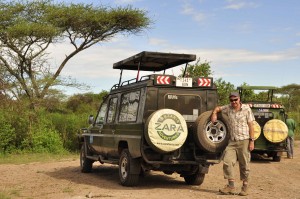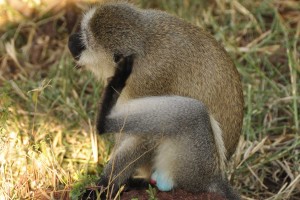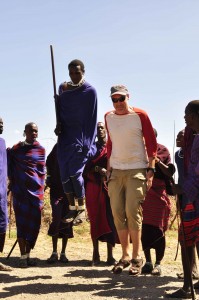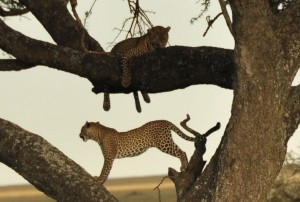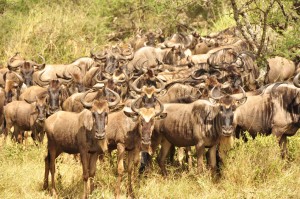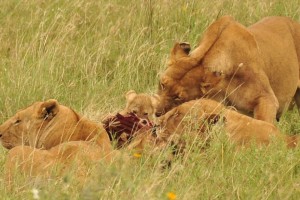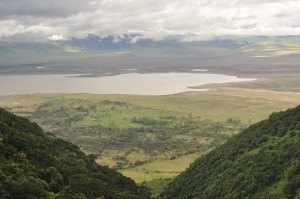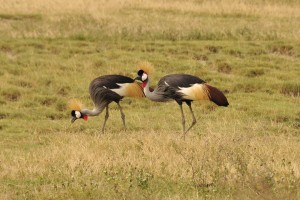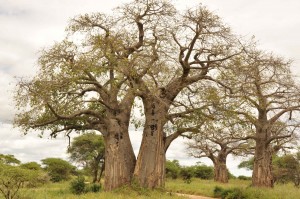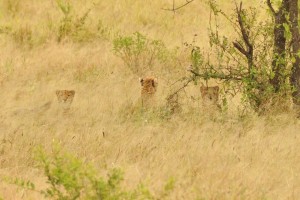Ego bruised and body still numb from our Kilimanjaro adventures, stage two of our Tanzanian explorations involved a 5 day camping Safari taking in 4 of Tanzania’s national parks, with emphasis on the big 2 – the Serengeti & the Ngorongoro crater. We had chosen to do a combined climbing /safari package with Zara Adventures as this seemed to offer better value for money and was just plain easier really. While still exorbitant, it provided us with a quality budget camping safari scenario and we had also taken a liking to the hotel’s free wifi, hot shower, dining and laundry facilities that nicely bookended each stage of our journey. All up, this combined part of our travels though was far from cheap, eating close to 10% of our overall travel budget – but we were in Africa and somehow it seemed the right thing to do.
After being introduced to our driver / guide, Robert; our cook, Erasto and a superbly outfitted 4×4 LandCruiser, we were good to go. And after a few supply stops, we left Moshi, a peaceful town at the foothills of Kilimanjaro at about 10.30am and set off North towards our first stop – Manyana National Park.
The drive was a story in itself, perhaps acutely focused by the inability of my limbs to do anything at this point in time the eyes became transfixed by the changing landscape. Moshi is lush, green and verdant – the fields packed with coffee, banana’s and maize (corn). As we rolled past Arusha, the major town that serves as the launching part for Northern Tanzania and the Safari industry, maize became the predominant crop. As the plains appeared and the maize thinned, so too did small herds of goats and sheep, round thatched huts and red clad locals – the distinctive signs of the Masai. The Masai are very a traditional tribe and custodians of the plains and savannahs of these parts for millennia, attired in combinations of red & purple hued tunics (to ward off lions), each carries a traditional walking stick (even on a bike), a sheathed knife and in the wilds a spear. Slowly the singular huts became circular villages (or Bomvu’s) – hemmed by thorny fences to keep out predators and protect their herds at night. The countryside increasingly revealed finely, grazed pastures, the hills dotted with hundreds of small herds of goats, sheep and cattle attended by distant red robed figures. About 3 hours into the drive, we passed a way point where a thousand nomadic Masai had gathered at an impromptu market – trading all manner of vegetables, livestock and other essentials. It was infinitely colourful, blissfully free of cars or tech of any kind; a scene that seemed as though it could have taken place anytime in the last several hundred years. Further on we passed what looked like a council meeting – 30 or so men robed in red, all calmly seated under a large Acacia tree engaged in animated discussion. As the people changed, so too did the landscape and the flat plains began became inundated with the thorny Acacia tree that so dominates the savannah areas, so too the distinctive Boab tree began to emerge; its swollen trunk and twisted tangle of bare branches, ghosting the skylines in all its aged glory.
Lake Manyara
Around mid afternoon we reached our campsite, its large tree’s a pleasant haven for nesting storks. As our car pulled up, a team of locals stripped our vehicle, erected our tents and kitchens, freeing us for an afternoon game drive. Manyara National Park was not particularly notable, a lucky dip entrée as our guide elegantly put it. The park is a thin strip hemmed between a large lake and the steep hills of the Rift Valley. We saw the usual fare here – elephants, buffalo’s, zebra, giraffe, gazelles, baboons and a huge array of birds. Still sore, our expectations and energy were pleasantly low and the sight of a ‘blue balled’ monkey served nicely as the peak of our afternoons entertainment.
Udupai Gorge & a Masai village
The next morning, we departed early for the drive across to the Ngorongoro crater rim, which we skirted on our way through to the Serengeti. Descending down the crater on the other side, we stopped in at the Udupai Gorge – an archaeological marvel. In the distinctive bedrock layers of the gorge, exposed over time by the rivers erosion, Mary & Louis Leakey in the 60’s and 70’s first discovered signs of mans prehistoric ancestors, dating to some 1.7 million years ago. While earlier remains have since been found in both South Africa & Ethopia, footprints of man have been found here that date to more than 3 million years old – one of the true crucibles of our species and an apt setting for lunchtime contemplations.
Perhaps inspired, we stop at a local Masai Bomvu and bribed a chief’s son $40 for a tour of his village. They met us with a traditional greeting; in separate groups of men and women, they chanted their welcome and commenced dancing, a dance famous for the vertical jumping of their male members. As we watched, first myself and then Megumi (with the women) were dragged in to participate and work our incredibly tight calves into some vertical hangtime – it was a pretty pitiful display by comparison, but fun nonetheless. The chief’s son, Paul then explains the key principles of the Masai & clever design of their nomadic camps during a brief tour – the gist being that they are polygamous; they only herd goats, sheep & cattle – eating the meat of all and mixing a concoction of cows blood and milk for drink; these livestock are their total livelihood and invaluable to them, their wealth determined by their numbers; when boys turn 18, they are sent out to roam for 2 years and only become men / married upon return after killing a lion! There is much more of course and Robert our guide, gives us some other great insights on the more modern reality of their role in society & conservation, albeit somewhat cynically afterwards. The tour finishes with offers to buy some of their jewellery – for more traditional minded folk they also really know how to fleece tourists.
The Serengeti
As we came down from the crater rim and onto the single, straight gateway road that provides access to the Serengeti, the skies clear and the perspective is radically transformed. Serengeti is Masai for ‘endless plain’ and it couldn’t be a more perfect description. Before us, the flat treeless, ankle high yellow grassed expanse, opens up as far as you can see, you can actually see the earth bend on the horizon – something I’ve only experienced ever before in the Australian outback. Hundreds of thousands of gazelle, zebra, ostrich and other game roam freely either side of the road on a scale that is hard to fathom. The wildebeast and other larger animals have already left this area though, moving deeper into the centre of the park now that the higher grass has gone and things are starting to dry out. This is the foundation of the ‘great migration’ that builds steam in later July / August to become one of the worlds greatest natural wonders, we hoped to catch its infant stages later on and had planned our trip here accordingly. After another 30 minutes or so driving in a straight line into the plain, we finally encounter some trees, a rocky outcrop and giraffes – the entrance to the park. We had only just arrived in the Serengeti and already we were wonderstruck by the sheer presence of the place.
We had planned to camp in the middle of the park, so after registration at the gate, we took a slow game drive for the afternoon, as a roundabout way of getting there. We had briefed Robert our guide that we were really here to see cats & the migration, particularly cheetah and the elusive leopard having already seen most other things. He rapidly tuned through the CB channels to find the rangers station and other drivers that he knew and within minutes had teamed up with another driver from Zara. We then sidetracked and headed North across a rough dirt track, this is prime cheetah country he said. Sure enough, after a while of seeing nothing but grass, we stumbled across a young cheetah with a fresh kill – impala. Particularly sensitive and freaking out about the car, it was ready to abandon the kill without eating, so we let it be – Robert had also intercepted another ranger call – there were leopard sightings, safari’s great rarity. He stepped on the gas and 30 rough minutes later we were facing 2 leopards in a tree, obliviously engaged in a courting ritual. The female jumping around the tree, shaking her bits in an enticing, seductive dance – the male simply lazing away, either already worn out or simply not interested. It was an absolute rare event of the highest calibre and captivating for all. Since it was getting dark, we tore ourselves away all too soon, as we still had to set-up camp for the night, but in so doing chanced on a lion, up a tree. We had been in the park 3 hours and had already ticked off most of our ‘safari wants’ – what a place!
That night, we camped in a small campsite; it featured basic toilets and dining areas caged off as protection from hungry animals. We were then warned to stay in our tents all night in spite of any emergency toiletry needs – there were no fences here and animals of all kinds liked to wander through. Sure enough, after eating a sumptuous camp feast prepared out of thin air by our chef Erasto, at about 9.00pm, a large male lion started roaring at the edge of the campsite, a few hundred metres from our tents at most. The loud call was him distinctly marking his territory, letting everyone know whose land this was. Captivated and not without a bit of trepidation, I stood in the middle of the campsite until quite late, chatting to an Aussie musician, Simon and a few other campers, while the lion slowly roared its way around our perimeter – there are no words to really describe the thrill and awe this experience inspired or for that mater the hyena cries later on, as they patrolled in the lions wake.
The next day we woke with the sunrise to head further into the centre – our goal was to catch the illusive migrating wildebeast as they started to chaotically form the groups and mass that would later tally in excess of a million as it stampeded its way into Kenya. For a few hours we were treated to little more than elephants, ostriches and vultures, so Robert stopped for a late breakfast at a hippo pool. There is nothing like seeing 300 hippo’s crowded all over each other, fighting and moaning to kickstart a days sightseeing, let me tell you. Shortly after this, we found our first wildebeast herd – a group numbering some 10 thousand or more charging through the undergrowth madly in one direction, getting tired, resting and then tearing off in another. They will do this for the next month, slowly building in number as the groups coalesce and fine tuning their direction based on water supply – even on this small scale though, the site is still exhilarating. We came across several other such groups that day, as well as herds of elephants, crocodiles and our big prize, a large pride of 20 or so lions that had just killed a buffalo. As we were pulling up to the site, a lioness emerges from the grass right in front of our vehicle to cross the road to the kill – to our amazement (and Megumi’s lifetime fantasy) a small procession of 5 tiny lion cubs then follow the lioness out of the bushes in single file – pure magic. We spent several hours simply watching this extended lion family feasting, sleeping and enjoying their afternoon spoils.
The next morning, we woke up to an elephant in the camp, a large herd was passing by and a big bull came to the campsite to investigate all the noise. (A large migrating herd of dutch football fans had arrived late in the night, driving orange cars of all description and making plenty of noise!) When Megumi tried to get close for a photo she was soundly trumpeted for her efforts.
The Ngorongoro Crater
As we drove back through the Serengeti and the fields of game to the Ngorongoro crater, I could not help feel a sense of complete awe at this place. I honestly doubted there is anything that can compare to this from a safari perspective, everything else we had seen felt like a zoo or controlled environment in comparison. Yet, as we climbed up to the crater rim away from the sunshine and through the rain and clouds, then descended back down to the sunny floor of the Ngorongoro crater national park, a new wonder was revealed.
Ngorongoro is a volcanic crater about 25 km in diameter, surrounded on all sides by walls that rise more than 500m upwards, to create one of natures most stunning natural amphitheatres. Creating its own set of unique microclimates, the crater forms dense, impenetrable jungle in a cloud layer at the top, combining with the sheer walls to provide perfect isolation from the outside world. The floor of the crater is largely a flat treeless plain, with a large lake forming the centre, a marshland in one corner and a forest in another and also consuming the surrounding walls. During rainy season the roads in and out (there are only 2) become impassable and even now it was too much for a few 4×4’s. Leaving we were forced to give a lift to a Finnish couple whose safari vehicle’s radiator had burned out on the ascent.
Once down on the floor, every form of African wildlife was in abundance and immediately accessible at close quarters. In our 6 hour drive around, we saw more than 20 lions, several different prides all resting uncaring in the sun or on roads – old males, lionesses, young cubs. Elephants roamed the marshlands, while hippo’s escaped the sun in the fresh water ponds. On the plain thousands of zebra, buffalo, wildebeest, rhino, antelope and gazelle graze side by side with ostrich, flamingos, storks and pelicans. We were treated to a cheetah resting under a tree, numerous hyena roaming and a rare sighting of a large civet cat. But perhaps the most stunning of all was the Ugandan, clown crane – simply the most beautiful bird I have ever beheld.
If the Serengeti was stunning for its raw scale; Ngorongoro is more than its equal, simply because it forms the world’s most perfect natural biosphere. The descent into (and out) of the crater feels like a descent into another world entirely. I would suggest that the inspiration for Spielberg’s movie Jurassic Park stems largely from here.
Tarangire National Park
On a post crater high, we returned to the same campsite near Manyara National Park (together with our Finnish rescuee’s) and next day rose early again for our final game drive, the Tarangire. By now, we had seen everything we had really dreamed of and this represented simply a scenic route home. The Tarangire is a large national park that is very popular in the dry season, but during the wet tends to clear of animals. The wet marsh and riverbed becomes unpleasant to most of the wild animals underfoot (think footrot), so they migrate out of the park and return when it’s drier. Consequently our expectations where not particularly high here and our real interest was the stunning collection of great and ancient boab tree’s that pepper the parks landscape.
As we started the drive, the huge ancient boabs immediately stole attention and after a while thus absorbed, we stumbled across a 4×4 bogged axle deep in the mud, attempting to cross one of those roads that screams out for avoidance. We then spent the next hour watching 2 Irishman try every innovation imaginable to try and free the thing – apparently their first day on a self drive safari – it’s a pretty tough school!
True to form, there was little game here – we saw a few elephants, some giraffe’s and the odd waterbuck as we drove around, but Robert had heard that there were 2 cheetahs up ahead near a waterhole somewhere. As he pulled up approximately at the site, we assumed we had missed them, but cautioned otherwise we settled down to watch and wait, Robert convinced they were just resting in the grass somewhere and would stick their head up eventually if we were patient. After what seemed like half an hour of close attention (plus a bit of whistling and banging truth be told), Megumi spotted a cheetah head perhaps 70m from the road and we watched as it rose, walked across a few metres and lay down again under a tree. A bit more waiting, whistling and banging and suddenly 3 cheetah heads popped up – a whole family. In a park without animals, somehow we had hit the jackpot, likely the only one around as well.
In all, it capped off a remarkable 5 days. Megumi was in raptures – it was animal planet and more in the flesh and her absolute dream. As for me, it was everything I dreamed a safari and the magical African adventure should be. Worth every cent and as an experience something that will live long in the memory!
![On Safari in Tanzania Ego bruised and body still numb from our Kilimanjaro adventures, stage two of our Tanzanian explorations involved a 5 day camping Safari taking in 4 […]](http://meltingplots.com/wp-content/uploads/2010/05/zebra2.jpg)
